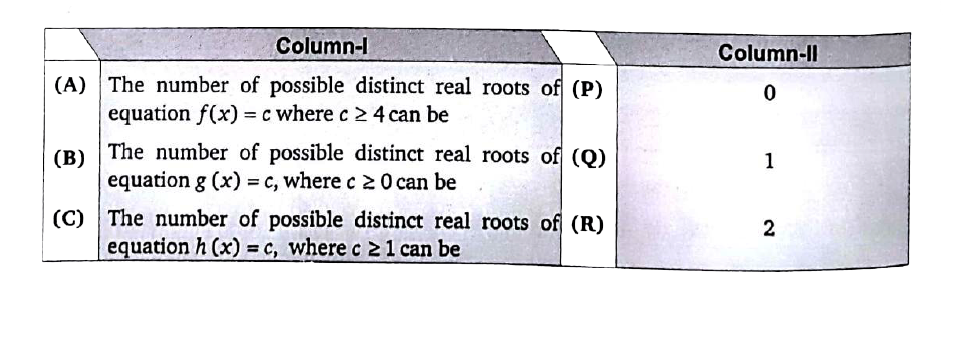Let then the largest vlaue of is:
The correct Answer is:B
To find the largest value of the function f(x)=x2+x−1x2−x+1 for x in the interval (−1,3), we will follow these steps:
Step 1: Find the derivative of f(x)
We will use the quotient rule to find the derivative f′(x):
f′(x)=(u′v−uv′)v2
where u=x2+x−1 and v=x2−x+1.
Calculating u′ and v′:
- u′=2x+1
- v′=2x−1
Now applying the quotient rule:
f′(x)=(2x+1)(x2−x+1)−(x2+x−1)(2x−1)(x2−x+1)2
Step 2: Set the derivative to zero
To find the critical points, we set the numerator equal to zero:
(2x+1)(x2−x+1)−(x2+x−1)(2x−1)=0
Step 3: Solve the equation
Expanding both terms and simplifying:
2x3−2x2+2x+x2−x+1−(2x3−2x2+2x−x2−x+1)=0
This simplifies to:
−2x2+4x=0
Factoring gives:
2x(2−x)=0
Thus, the critical points are x=0 and x=2.
Step 4: Evaluate f(x) at critical points and endpoints
We need to evaluate f(x) at the critical points and the endpoints of the interval (−1,3):
1. f(−1)=(−1)2+(−1)−1(−1)2−(−1)+1=1−1−11+1+1=−13=−13
2. f(0)=02+0−102−0+1=−11=−1
3. f(2)=22+2−122−2+1=4+2−14−2+1=53
4. f(3)=32+3−132−3+1=9+3−19−3+1=117
Step 5: Compare values
Now we compare the values:
- f(−1)=−13
- f(0)=−1
- f(2)=53
- f(3)=117
The largest value among these is f(2)=53.
Conclusion
Thus, the largest value of f(x) in the interval (−1,3) is:
53
We will use the quotient rule to find the derivative f′(x):
f′(x)=(u′v−uv′)v2
where u=x2+x−1 and v=x2−x+1.
- u′=2x+1
- v′=2x−1
f′(x)=(2x+1)(x2−x+1)−(x2+x−1)(2x−1)(x2−x+1)2
To find the critical points, we set the numerator equal to zero:
(2x+1)(x2−x+1)−(x2+x−1)(2x−1)=0
Expanding both terms and simplifying:
2x3−2x2+2x+x2−x+1−(2x3−2x2+2x−x2−x+1)=0
This simplifies to:
−2x2+4x=0
Factoring gives:
2x(2−x)=0
Thus, the critical points are x=0 and x=2.
We need to evaluate f(x) at the critical points and the endpoints of the interval (−1,3):
1. f(−1)=(−1)2+(−1)−1(−1)2−(−1)+1=1−1−11+1+1=−13=−13
2. f(0)=02+0−102−0+1=−11=−1
3. f(2)=22+2−122−2+1=4+2−14−2+1=53
4. f(3)=32+3−132−3+1=9+3−19−3+1=117
Now we compare the values:
- f(−1)=−13
- f(0)=−1
- f(2)=53
- f(3)=117
Thus, the largest value of f(x) in the interval (−1,3) is:
53
Topper's Solved these Questions
- QUADRATIC EQUATIONS BOOK - VIKAS GUPTA (BLACK BOOK)CHAPTER - QUADRATIC EQUATIONS EXERCISE - EXERCISE (ONE OR MORE THAN ONE ANSWER IS/ARE CORRECT)
44 Videos
- QUADRATIC EQUATIONS BOOK - VIKAS GUPTA (BLACK BOOK)CHAPTER - QUADRATIC EQUATIONS EXERCISE - EXERCISE (COMPREHENSION TYPE PROBLEMS)
23 Videos
- PROBABILITY BOOK - VIKAS GUPTA (BLACK BOOK)CHAPTER - PROBABILITY EXERCISE - Exercise -5 : Subjective Type problems
12 Videos
- SEQUENCE AND SERIES BOOK - VIKAS GUPTA (BLACK BOOK)CHAPTER - SEQUENCE AND SERIES EXERCISE - EXERCISE (SUBJECTIVE TYPE PROBLEMS)
21 Videos
Similar Questions
Knowledge Check
Let f(x)=x2+x−1x2−x+1, In above problem, the range of f(x)∀x∈[−1,1] is:
A[−1,35]B[−1,53]C[−13,1]D[−1,1]Let f(x+1x)=x2+1x2,(x≠0) then f(x) equals
Ax2− for all xBx2−2for all|x|>2Cx2−2for all |x|<2Dnone of theseLet f(x)=x2−x+1,∀x≥12, then the solution of the equation f(x)=f−1(x) is
Ax=1Bx=2Cx=12Dx=3
If f(x)+2f(1–x)=x2+1,∀x∈R, then the range of f is :
View SolutionLet f(x)=x2−2xandg(x)=f(f(x)−1)+f(5−f(x)), then
View SolutionLet f(x)=x3−4(x−1)3∀x≠1,g(x)==x4−2x24∀x∈R,h(x)x3+4(x+1)3∀x≠−1,


View SolutionLet f(x)=x3+6x2+ax+2,if(−3,−1) is the largest possible interval for which f(x) is decreasing function, then a=
View SolutionLet f:R→andf(x)=x(x4+1)(x+1)+x4+2x2+x+1, then f(x) is :
View Solution
